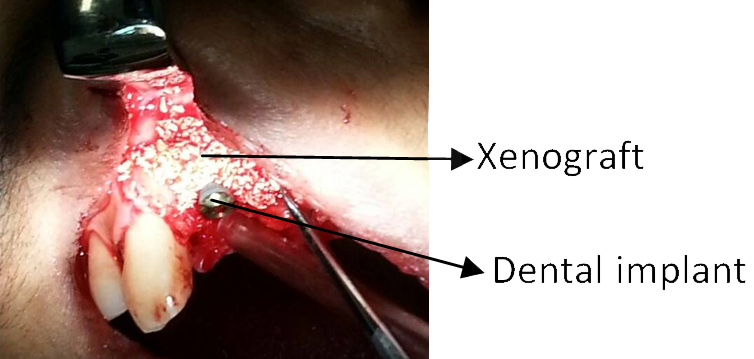Introduction
Bone graft is defined as a hard tissue that is transplanted and expected to become a part of the host to which it is transplanted. Bone grafting is a surgical procedure that replaces missing bone.
Principle Of Bone Regeneration
Bone has the ability to regenerate if the surrounding condition is appropriate. When bone is transplanted from one area of the body to another, several processes become active during the incorporation of the graft. When the graft is first removed from the body, the blood supply has been severed. Thus, the cells in the bone graft depend on diffusion of nutrients from the surrounding graft bed (area where the graft is placed) for survival. A cycle of bone resorption, replacement and remodelling begins until mature bone is formed. The amount of bone form depends on the amount of viable cells that are successfully transplanted1.
The biologic mechanisms involve for bone grafting are osteoconduction, osteoinduction and osteogenesis2.
Osteoconduction occurs when the bone graft material acts as a scaffold for new bone formation. Osteoblasts (Cells which form bone) from the surrounding tissue utilize the bone graft as a template to form new bone.
Osteoinduction is a process that osteoprogenitor cells ( immature cells ) are stimulated to differentiate into osteoblast that produces new bone. One of the osteoinductive cell mediators is bone morphogenetic proteins.
Osteogenesis is a process when osteoblasts originating from the bone graft producing new bone.
Type Of Bone Graft
Autogenous graft (autograft) is composed of tissues from the same individual. Fresh autogenous bone is the most ideal bone graft material. It is harvested from non-essential bones like the iliac crest, ribs, and lower jaw. It is unique among bone grafts in that it is the only type of bone graft to supply living, immunocompatible bone cells essential to osteogenesis. There is less risk of the graft rejection because it originated from the patient’s own body. The disadvantage is that this procedure necessitates another site of operation for harvest of graft.
Allogeneic graft (allograft, homograft) is graft taken from another individual of the same species. Allograft is taken from cadavers, or human bone donors who undergo total hip replacement surgery.The most commonly used allogeneic bone is freeze-dried. The individuals are usually genetically dissimilar, therefore the graft must be treated to reduce the antigenicity. All of these treatemetns destroy osteogenic cells in the graft for osteogenesis. The allogeneic graft only assists in osteogenesis, providing a template for bone remodelling. The advantage is that this procedure has no donor site morbidities.
Xenogeneic graft (xenograft, heterograft) is a graft taken from another species like bovine origin. The antigenic dissimilarity of this graft is greater than with allogeneic bone. The advantage is that this procedure has no donor site morbidities.
Alloplastic graft is made from hydroxylapatite, which is the main mineral component of bone. Other synthetic bone grafts are made of calcium carbonate, tricalcium phosphate, and fluorohydroxyapatitic composition from calcifying marine algae. Hydroxyapatite is widely used now because of its osteoconduction, hardness and acceptability by bone.
Indications
Dental implants
In cases of partially or fully edentulous (without teeth), one of the treatment options to restore the dentition is dental implant. Alveolar bone needs to be built up to support the dental implant. Dental implants need to be surrounded by bone so that it can be properly integrated and stays firm in the mouth.

Figure 1 : Xenograft used to restore the alveolar bone width.
Alveolar bone graft
In cases of alveolar cleft, there is a hole from the mouth to the nose. The cleft in the bone and gum causes teeth unable to erupt and the face had a ‘fallen in’ appearance. Alveolar bone grafting aims to repair the hole in the bone, provide bone for the permanent teeth to erupt and to support the base of the nose. The best time to perform the surgery is when the child is 8-9 years old when the permanent canine tooth is three quarters formed. During the surgery, bone graft (usually autogenous) is placed into the gap.
Other indications
Sinus lift procedure
Socket preservation
Reconstruction of a pathologic defect
References
- Larry J Peterson, Edward Ellis, James R Hupp, Myron R Tucker. Contemporary Oral and Maxillofacial Surgery, (4th edition)St Louis, Missouri: Mosby.646-59.
- Klokkevold PR, Jovanovic SA (2002). Advanced Implant Surgery and Bone Grafting Techniques. In Newman, Takei, Carranza. Carranza’s Clinical Periodontology (9th edition)Philadelphia: W.B. Saunders. 907-8.
| Last Reviewed | : | 3 Jun 2014 |
| Writer | : | Dr. Ling Xiao Feng |
| Accreditor | : | Dr. Marzuki b. Zainal Abidin |







